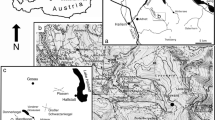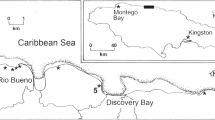Summary
Vermetids significantly contribute to the features of certain intertidal reefs. In the eastern Mediterranean, notably along exposed shores of Israel, these reefs are large eolianite platforms divided into rimmed flat basins. Their surfaces are incrusted by a dense cover of vermetid shells cemented by coralline algae—the rims by a crust of Dendropoma petraeum, 10–15 cm thick, and the surrounded basins by Vermetus triquetrus, usually less than 5 cm thick. These two species live in very different environments—the rims are incessantly surfswept and often exposed to air while the basins are usually watercovered and relatively calm. Accordingly, Dendropoma differs from Vermetus in certain morphological and anatomical characters, as well as in feeding mechanisms. There is circumstantial evidence that their crust has a protective effect on the underlying rock and is the controlling factor in the development of these platforms.
Less common and smaller vermetid-covered reefs of the Israeli shore are circular limestone formations, in which an outer rim incrusted by D. petraeum surrounds a single shallow basin incrusted by V. triquetrus. These small reefs, resembling miniature atolls, show superficial similarity to intertidal reefs in Bermuda, where certain environmental conditions are rather similar to those prevailing in the eastern Mediterranean. As in Israel, a species of Dendropoma, D. irregulare, is an important component in the composition of the reefs, though there is no Vermetus. Also, coralline algae do not function just as cement but are a significant component.
Both in Israel and in Bermuda such reefs develop when erosion, brought about by the encroaching sea, is hindered by the protective biogenetic crust. In Israel this crust never increases in thickness beyond a certain level because by the time the rising sea-level permits further upward growth, the reef has already collapsed under the combined action of boring organisms and waves. In Bermuda, voids and borings within the reef are rapidly filled-in and cemented, mainly by transported calcareous debris. Instead of borers and waves weakening it, the Bermudan reef is consolidated and does not readily collapse, and the thickness of its organic crust is remarkable. Thus, the Bermudan “microatolls” are genuine wave-resistant reefs. Their growth is initiated and perpetuated by vermetids and coralline algae. Though a large portion of their framework is removed, it is replaced by a secondary deposition and cementation of other lime-secreting organisms and debris.
Similar content being viewed by others
References
Agassiz, A.: Notes from the Bermudas. Amer. J. Sci. 47, 411–416 (1894)
Agassiz, A.: A visit to the Bermudas in March, 1894. Bull. Mus. Comp. Zool. Harv. 26, 209–279 (1895)
Blanc, J. J., Molinier, R.: Les formations organogénes construites superficialles en Méditerranée ocoidentale. Bull. Inst. Océanogr., Monaco 52 (1067), 1–26 (1955)
Crossland, C.: The oecology and deposits of the Cape Verde marine fauna. Proc. zool. Soc. Lond. 1, 170–186 (1905)
Crossland, C.: Reports on the marine biology of the Sudanese Red Sea, from collections made by C. Crossland. III. Note on the formation of the shore-cliff near Alexandria. J. Linn. Soc. (Zool.) Lond. 31, 10–13 (1907)
Ekman, S.: Zoogeography of the sea, p. 54. London: Sidgwick and Jackson 1953
Emery, K. O.: Marine solution basins. J. Geol. 54, 209–228 (1946)
Emery, K. O., Neev, D.: Mediterranean beaches of Israel. Bull. Geol. Surv. Israel 26 (1960)
Fevret, M., Sanlaville, P.: Contribution a L'etude du littoral libanais. Mediterranee 2, 113–134 (1965)
Ginsburg, R. N., Shinn, E. A., Schroeder, J. H.: Submarine cementation and internal sedimentation within Bermuda reefs. Program Ann. Meeting Geol. Soc. Amer., p. 78–79 (1967)
Hadfield, M. G., Kay, E. A., Gillette, M. N., Lloyd, M. C.: The Vermetidae (Mollusca: Gastropoda) of the Hawaiian Islands. Mar. Biol. 12, 81–98 (1972)
Heilprin, A.: The Bermuda Islands, p. 20. Philadelphia: Philadelphia Academy of Natural Sciences 1889
Hesse, R., Allee, W. C., Schmidt, K. P.: Ecological animal geography, p. 252. New York: Wiley 1951
Huvé, P.: Contribution preliminaire a l'étude des peuplements superficièles des côtes rocheuses de Méditerranée orientale. Recl. Trav. Stn. Mar. Endôume 21 (12), 50–65 (1957)
Keen, M.: A proposed reclassification of the gastropod family Vermetidae. Bull. Br. Mus. Nat. Hist. 7, 15–213 (1961)
Kempf, M., Laborel, J.: Formations de vermets et d'algaes calcaires sur les côtes du Brésil. Recl. Trav. Stn. Mar. Endôume 43, 9–23 (1968)
Land, L. S., Mackenzie, F. T., Gould, S. J.: Pleistocene history of Bermuda. Bull. Geol. Soc. Amer. 78, 993–1006 (1967)
Lipkin, Y.: Safriel, U.: Intertidal zonation on rocky shores at Mikhmoret (Mediterranean, Israel). J. Ecol. 59, 1–30 (1971)
Mackenzie, F. T.: Bermuda Pleistocene eolianites and paleowinds. Sedimentology 3, 52–64 (1964)
Mackenzie, F. T., Kulm, L. O., Cooley, R. L., Barnhart, J. T.: Homotrema rubrum (Lamarck), a sediment transport indicator. J. Sediment. Petrol. 35, 265–272 (1965)
Molinier, R.: Les Plate-formes et corniches récifals de Vermetus (Vermetus cristatus Biondi) en Méditerranée occidentale. C. R. Acad. Sci., Paris 240, 361–363 (1955)
Molinier, R., Picard, J.: Notes biologiques à propos d'un voyage d'étude sur les côtes de Sicile. Ann. Inst. Océanogr. Monaco 28, 163–188 (1953)
Morton, J.: Structure and adaptations of the New Zealand Vermetidae. Proc. roy. Soc. N. Z. 79, 1–51 (1951)
Morton, J.: Form and function in the evolution of Vermetidae. Bull. Br. Mus. Nat. Hist. 2 (9), 585–630 (1965)
Nelson, R. J.: On the geology of the Bermudas. Trans. Geol. Soc. Lond. 5, 103–123 (1840)
Pérès, J. M., Picard, J.: Les corniches calcaires d'origine biologique en Méditerranée occidentale. Recl. Trav. Stn. Mar. Endôume 4 (1), 2–33 (1952)
Pérès, J. M., Picard, J.: Considerations sur l'étagement des formations benthiques. Recl. Trav. Stn. Mar. Endôume 11 (18), 15–30 (1956)
Picard, J.: Les formations organogenes benthique Méditerranées et leur importance geomorphologique. Recl. Trav. Stn. Mar. Endôume 8 (13), 55–76 (1954)
Picard, L.: Structure and evolution of Palestine. Bull. Geo. Dep. Heb. Univ. Jerusalem 4, 1–187 (1943)
Prat, H.: Remarques sur la distribution des organisms dans les eaux littorales des Bermudas. Bull. Inst. Océanogr., Monaco 705, 1–20 (1936)
Revelle, R., Emery K. O.: Chemical erosion of beachrock and exposed reef rock. Bikini and adjacent atolls, Marshall Island. U.S. Geol. Surv. Prof. Pap. 206T, 699–709 (1957)
Safriel, U.: Recent vermetid formation on the Mediterranean shore of Israel. Proc. malac. Soc. Lond. 37, 27–34 (1966)
Shier, D. E.: Vermetid reefs and coastal development in the Ten Thousand Islands, Southwest Florida. Bull. Geol. Soc. Amer. 80, 485–508 (1969)
Stanley, D. J., Swift, D. J. F.: Bermuda's southern aeolianite reef tract. Science 157, 677–681 (1967)
Stephenson, A., Stephenson, T. A.: The Bermuda Islands. Endeavour 23, 72–80 (1954)
Termier, H., Termier, G.: Erosion and sedimentation. Princeton: Van Nostrand 1963
Thomson, C. W.: The voyage of the Challenger. The Atlantic, p. 304. New York: Harper 1878
Verrill, A. E.: The Bermuda Islands: their scenery, productions, physiology, natural history and geology; with sketches of their early history and the changes due to man. Trans. Conn. Acad. Arts Sci. 11, 413–857 (1901–1902)
Verrill, A. E.: The Bermuda Islands. Part IV. Geology and paleontology and Part V. An account of the coral reefs. Trans. Conn. Acad. Arts Sci. 12, 45–205 (1905–1906)
Younge, C. M.: Notes on feeding and digestion in Pterocera and Vermetus. Sci. Repts G. Barrier Reef Exped. (Brit. Mus., Nat. Hist.) 1, 259–281 (1932)
Younge, C. M., Iles, E. J.: On the mantle cavity, pedal gland and evolution of mucous feeding in the Vermetidae. Ann. Mag. Nat. Hist. 3, 536–556 (1939)
Author information
Authors and Affiliations
Additional information
Contribution No. 631 from the Bermuda Biological Station.
Rights and permissions
About this article
Cite this article
Safriel, U.N. The role of vermetid gastropods in the formation of Mediterranean and Atlantic reefs. Oecologia 20, 85–101 (1975). https://doi.org/10.1007/BF00364323
Received:
Issue Date:
DOI: https://doi.org/10.1007/BF00364323




